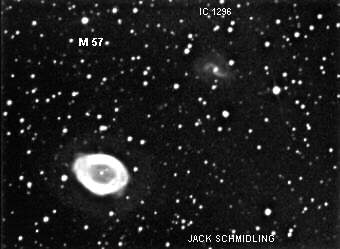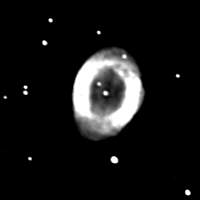
CCD IMAGING
Jack Schmidling Productions, Inc.
18016 Church Road ~ Marengo IL 60152
Phone:815 923 0031 ~ Email:arf@mc.net
| Telescopes | Astro Photos | JSP Homepage |
The major problem with video in astronomy is that the exposure time is fixed by the technology and products on the market. This time is too short to gather enough photons to show faint objects like galaxies and emission nebulae. To solve this problem the digital camera was developed which allowed the chip to be exposed for longer periods of time and the entire image "downloaded" when the exposure is ended. This provides a technology similar to long exposure photography with several important differences.
The most important difference on the plus side, is that it elimintes recovering and processing film from remote sites such as the Hubble Space Telescope. On the downside, it is very complicated and expensive to implement compared to film and because of cost, only NASA (read taxpayers) could afford (if one existed) a CCD camera with a chip as large as a piece of film.
NOTE: Amateur astronomers have chosen to call this technology simply CCD and make no distinction between digital and video so when the term CCD is seen, one can just assume digital CCD is meant as opposed to film. Furthermore the art is called imaging and the picture is called an image instead of a photo. The artist is called an imager. As much as I dislike being ambiguous, I will follow the crowd to some extent.
So-called "guiding" is necessary on photos (or images) of more than a few seconds because even the most elaborate and precise clock driven telescope will not compensate for the rotation of the Earth precisely enough to maintain perfect pinpoint images of stars. Tracking errors show up on photos/images as elongated dots or in very bad cases as lines instead of stars.
Guiding is accomplished through the use of a second smaller telescope firmly attached to the primary. This guidescope is aimed at the object or a nearby star and carefully located in the crosshairs of a guiding eyepiece. During the exposure, the telescope controls are continuously adjusted to keep the star precisely on the crosshairs. This of course, can be very tedious for long exposures, especially under harsh climate with mosquitoes, eyestrian and other natural urges further adding to the fun.
This grunt work is a piece of cake for a computer and all it needs is feedback to tell it what to do. The CCD autoguider is just the device to provide the feedback and really takes all the drudgery out of astrophotography/imaging. Once the star is located in the crosshairs, the eyepiece is replaced by the autoguider head and one can leave it unattended for hours, knowing that it is doing a far better job than the imager could do manually. I highly recommend that any aspiring astrophotographer take a few hand guided exposures just to gain an appreciation of this marvel before using one.
All this goes on under the blind faith that the CCD is actually seeing something while guiding and one can't help wanting to know just what the CCD is "seeing". Even a committed astrophotographer like myself, gets this urge now and then. However, it requires actually having a PC on site to capture the images and until recently, I had no convenient way to do this.
My daughter's company was replacing it's older computers and she gave me a laptop that was destined to satisfy this urge. There are severe limits to what can be done with a $900 autoguider as compared to a full-blown CCD imaging camera, costing thousands but I have found a few classes of objects that lend themselves to what it can do well. Two such objects are bright planetary nebulae and globular star clusters. The following image is one of the brightest and most popular of the planetary nebulae.

The next night I set out to get a good image of the galaxy along with M57 in the same field for reference. I took a single 20 minute exposure and after processing it the next day, I went looking for other images but found nothing comparable until I got to the Palomar Schmidt photo (DSS). My joy was unbounded when I found star after star on my image that I could not see on the Palomar image.
It is truly mind boggling that a modest amateur telescope with the latest electronic technology can do today, what the greatest telescopes of only a decade or two ago could do. I invite you to compare the two images below. The only edge the Palomar image has is that it seems to be more sensitive to the emission wavelength of the halo around M57 than the CCD camera. I would also presume that something, no doubt has been lost, between the original plate and the DSS image.


It should be noted that seeing "star after star" is not is not for the casual observer. You might have to move the images off line to optimize the contrast and brightness for your particular viewer. Furthermore, it takes a trained eye to see the very faintest stars on images and make useful comparisons. Finally, my image was re-scaled smaller so the two images could be presented side by side on a web page for easy comparison and of course, both images have been compressed to save bandwidth. I have no clue as to why my image is brighter on the right side.

Just for references, the Ring lies at a distance of about 1500 light years and IC 1296 at about 320 million light years. It's a bit like lining your thumb up with a distant mountain.
For the complete story onM57 and more images: The Ring Nebula
The CCD image was taken with a Starlight Express MX5-16 integrating CCD camera. The exposure was 20 minutes and a 20 min dark frame was subtracted. Guiding was with the ST4 and Lumicon Off-axis guider.
For the most recent Astrophotos of the Week... RECENT PHOTOS